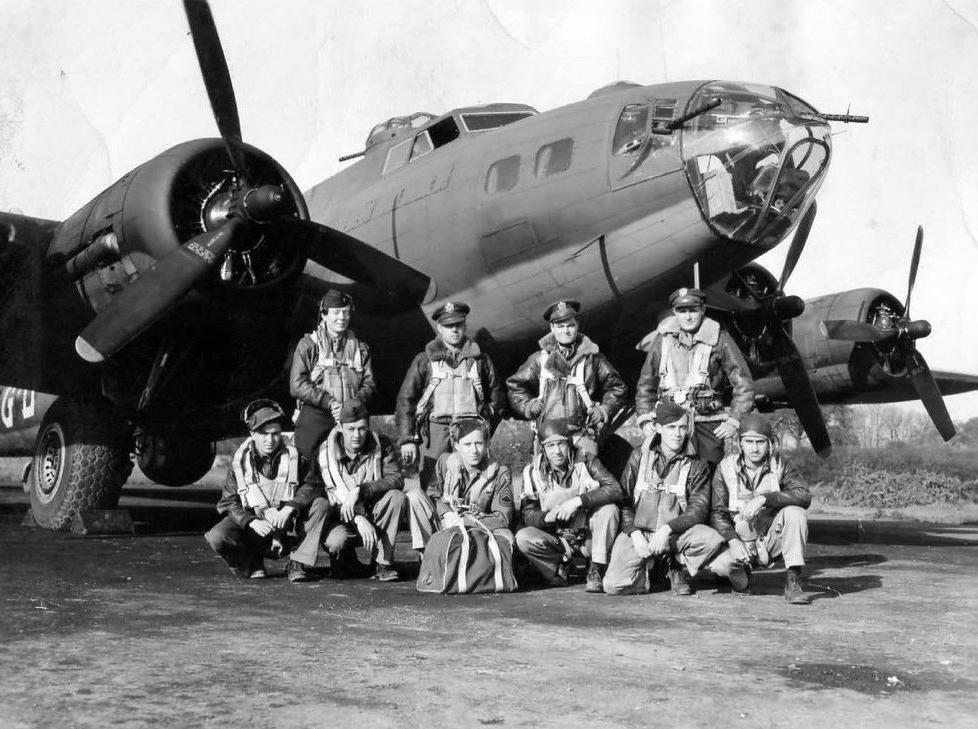
World War II National Air Forces: U.S. Army Air Corps--Planning

Figure 1.--The Boeing B-17 was first flown in 1935 and became operational in 1938 just as Hitler was threatening Europe with his Luftwaffe. It was perhaps the most iconic American airplane of the War. It was bristing with defensive armament--fixed and moveable guns. The press when they saw it, christened the plane 'The Flying Fortress'. (Note the front facing machine guns. This was not part of the B-17s orgininal armament, but gerrt-eigged by the crews when the Gernan fighter pilots figured out that the safest direction to attack a B-17 was head on.) The B-17 became the centerpiece of the Army Air Corps war planning. American Air Commanders who became known as the 'Bomber Boys' were sure that it could fight its way into enemy airspace during the day without fighter escorts and hit targets with percission accuracy. This is a B-17 with the 8th Air Force's 381st Bomb Group at Ridgewell Airfield, in Essex. The AAC's pre-War assessment would prove wildly optimistic, but the B-17 would be the primary platform that would tear the heart out of industrial Germany and level Berlin and the other cities of the Reich. Thankfully for American bomber crews, the United States had the industrial capacity to also build the fighter escorts that would be need for the bombers and well as by the Army for close air support.
|
|
World War I ended before planned stratehgic bombing campaigns could begin. Military strategists in the inter-War period debated the use of air power. More than any other country the United States decided to fight the next war with a massive air force. Funding was limited in the 1920s and even early-1930s when Hitler began to devote massive fund to the new Luftwaffe. President Roosevelt is known for his affinity with ships and the Navy. Less well known is his commitment toward building a massive air force, despite a bad experience with the Army Air Corps early in his administration. About 25 percent of American war spending was devoted to the air war. The British devoted an even higher percentage. Hitler was able to cow the Allies and gain stunning victories with a reltively small air force. Even by the time of the Battle of Britain, however, the British were already out producing the Germans in aircraft (July 1940) and American production was ramping up. American and Briish air commanders optimistically believed that the war could be won by air power alone. This would prove wrong, but they would make a major contribution to the War, both by strategic bombing and by by building a tactical, close ground suport capabiliy as well. Unlike the Germans, the Allies thanks to American industrial might had the capability of doing both. Ironically this was not the Army Air Corps' (AAC) intention. The AAC was dominated by Gen. Hap Aronold and the other Bomber Boys. They developed the iconic B-17 heavy bomber during the mid-1930s and they were convinced that squadeon of B-17s could fight their way into the Reich during the day and destroy targets with pin-point accuracy. The rare individual who questioned the bomber thesis like Claire Chennault had his career ruined. The British were skeptical for good reason. They pursued their bombing attacks at night. The American Bomber Boys would get their chace to test out their theroies after President Roosevelt and Prime-Miister Churchill announced the around the clock bombing of Germany at the Casablanca Conference (January 1943). It soon became onbvious that fighter escorts were needed. So much emphasis had been placed on bombing that the AAC gave little attention to tactical close air support. The Bomber Boys disliked the very sound of the phrase, espcially the idea of 'support'. They wanted to win the War. American enteresd the war with no tactical air doctrine. They were developing superb planes, but not doctrine or training. had superb planes, This would be developed in the field with very limited support from the Bomber Boys who dominated the AAC, but considerable support from Gen. Eisenhower and Brdley. The key figure would be Gen. Pete Quesada in the 9th Air Force who litterally wrote the book on tactical air doctrine in the 4 moths bedore D-Day. America also had the capability of buildiung a massive trnsport capability. The Axis powers had primarily tactical air forces. The Germans unlike their adversaries had developed close air support even before launching thewar. It was a critical aspect of their great victories. Both Germany and Japan began the bombing enemy cities from the very beginning. It proved an incredible mistake because they did not have the industrial capacity to build a strategic air force. The British and Amnericans did and by the end of the war, German and Japanese cities would be vast piles of rubble and ash.
CIH

Navigate the CIH World War II Pages:
[Return to Main World War II Army Air Corps page]
[Return to Main World War II national air forces page]
[Return to Main World War II aerial campaign page]
[Return to Main World War II page]
[Biographies]
[Campaigns]
[Children]
[Countries]
[Deciding factors]
[Diplomacy]
[Geo-political crisis]
[Economics]
[Home front]
[Intelligence]
[POWs]
[Resistance]
[Race]
[Refugees]
[Technology]
[Totalitarian powers]
[Bibliographies]
[Contributions]
[FAQs]
[Images]
[Links]
[Registration]
[Tools]
[Return to Main World War II page]
[Return to Main war essay page]
[Return to CIH Home page]
Created: 10:38 AM 6/26/2016
Last updated: 10:38 AM 6/26/2016



